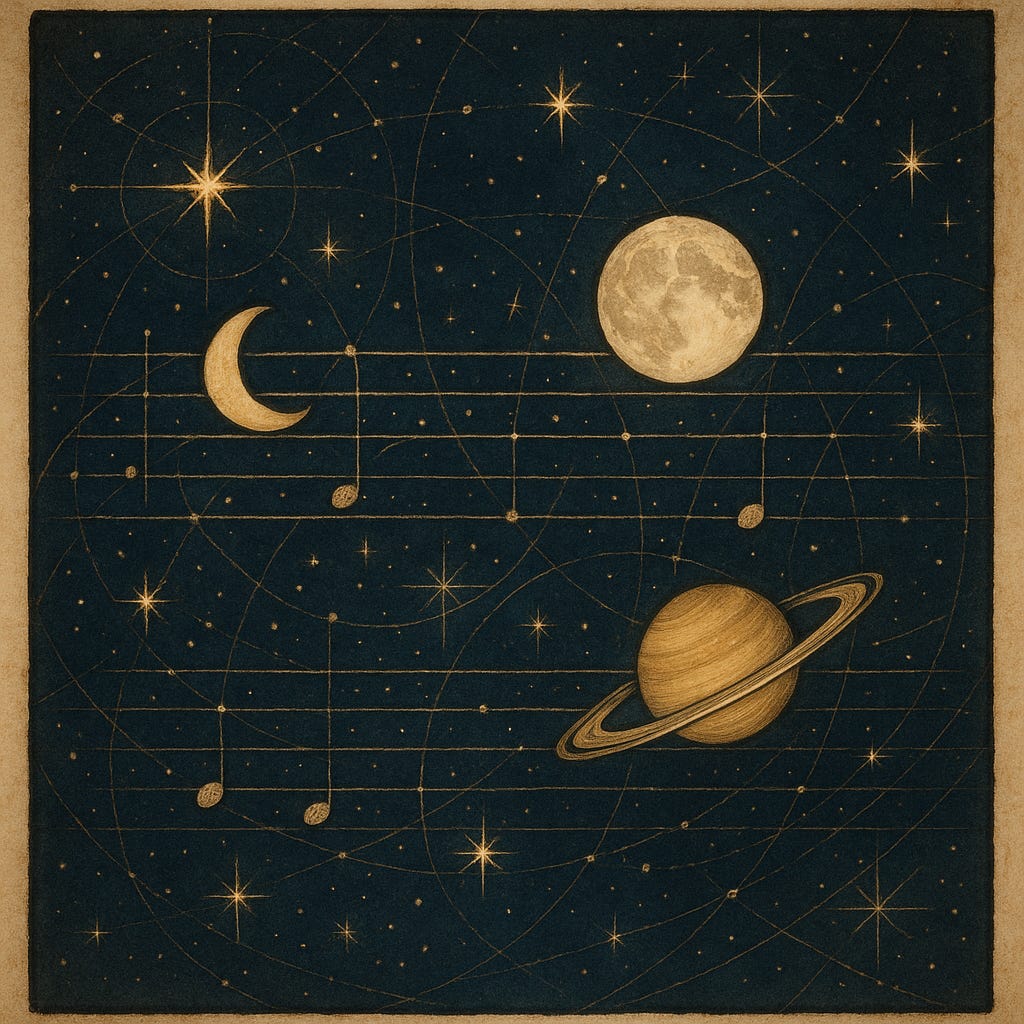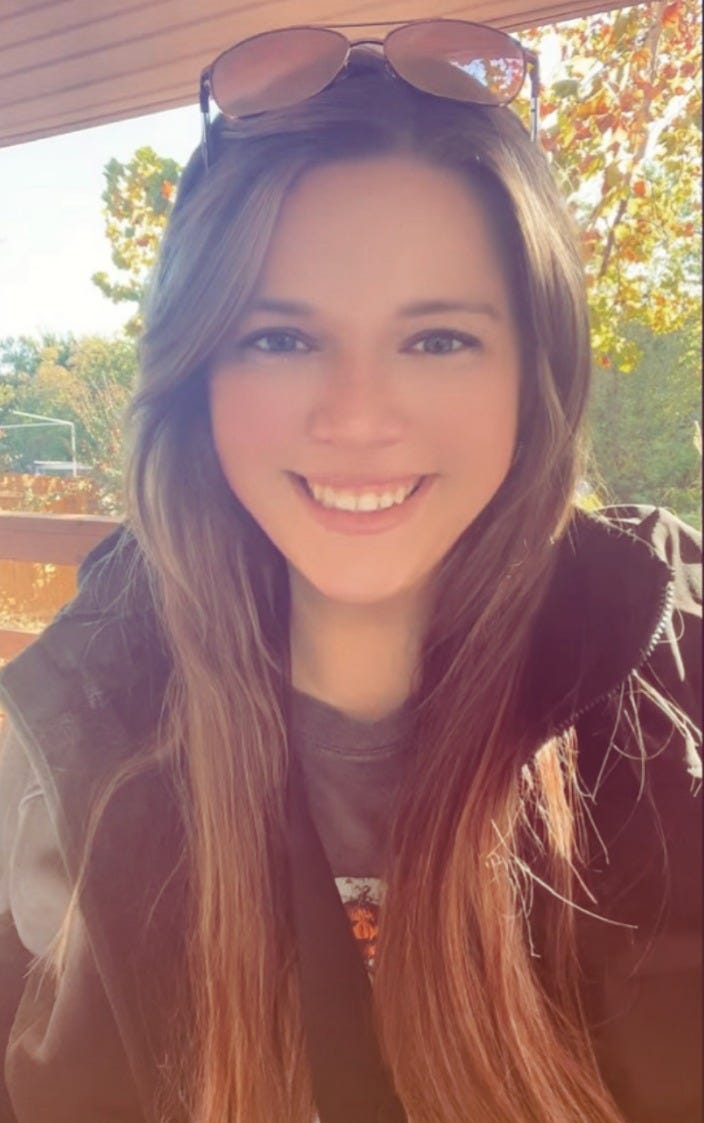Written by Rebecca M. Bell, Self-appointed Editor-in-Chief of The Literary Resistance
filed under: the music of maps/the maps of music
No sharps, no flats. Just starlight in C major.
There are two instincts that reveal us as a species: the urge to draw lines across the unknown, and the urge to make them sing.
Cartography and music are our oldest conspiracies against chaos. A map flattens the earth, a score flattens sound. Both take something wild—horizon, harmony—and pin it to a page, convincing us that infinity might be folded into pocket size.
This has always been our human trick: to translate the immeasurable into a system, to make the cosmos legible. The Babylonian star charts, the Gregorian chant, the earliest sailors steering by constellations—they all belong to the same genealogy. People pointing at the sky and insisting: This can be read. This can be played.
But to read and to play are not neutral acts. They are political ones. To map is to claim; to compose is to choose what dissonance will be tolerated. Every atlas has borders that cut through someone’s home. Every score has silences where someone’s note was omitted.
Which is why I want to linger in a key that resists complication: the Key of C. No sharps. No flats. The natural state.
Maybe that’s where we begin again.
I. Staff Lines Across the Sky
The sky has always been a manuscript, whether we admit it or not.
Imagine the night horizon as a stave, those five familiar lines etched across the void. Now lift your eyes. Orion’s belt: three even notes, a motif steady as percussion. The Big Dipper: a ladle tipping a scale. Cassiopeia: a zig-zag that could be mistaken for syncopation.
Even the Milky Way itself—once mistaken for spilt milk, for the breast of Hera, for a celestial road—is just a smear of chords strung across the staff. It hums whether or not we are listening.
And don’t forget the silence. Music lives by what it withholds. The rests punctuate the measure. Likewise, the black between stars is not emptiness—it’s negative space, the pause that makes light meaningful. Without rests, music is noise. Without darkness, starlight is clutter.
It’s tempting to romanticize this, but the ancients were more practical. They mapped stars to survive: to plant crops, to cross oceans, to measure time. Navigation was not just metaphor—it was life and death. Yet even then, survival required imagination: to see a hunter in scattered points, or a pitcher pouring water, or a swan with its wings extended. Pure invention disguised as necessity.
We forget this. We inherit constellations as if they were there all along. But the truth is starker: someone once squinted long enough to draw a line between two bright dots and declare it a story. Cartography disguised as myth. Myth disguised as map.
What if we approached our own lives this way—not as fixed coordinates, but as constellations in progress?
II. Maps Made of Memory
The first maps we carry are not of continents but of childhood.
Everyone has their own cartography of the familiar: the route to school, the shortcut to a friend’s house, the grocery aisle where you once lost sight of your mother and thought the world had ended. These are maps written not in ink but in adrenaline, in nostalgia, in grief.
Memory makes strange geographies. A hallway can feel longer than a highway. A kitchen table can feel larger than a city square. The heart expands and contracts the scale as it pleases.
We carry these maps forward, often unconsciously. A smell, a song, a certain angle of sunlight—suddenly you’re dropped back onto a grid you thought you’d outgrown. The territory is gone, but the map remains.
Grief operates the same way. When someone leaves, their absence becomes a landmark. A house with lights off, a favorite restaurant you avoid, an anniversary date circled in black. The cartography of loss is as precise as any atlas. You can chart the contours of absence as surely as a coastline.
Here is the paradox: maps pretend to be objective, when in truth they are mirrors. They show us where we are not, as much as where we are. Every coordinate is also a confession: This is what I needed to know at the time. This is what I feared losing. This is what I loved enough to name.
So when I say I’m interested in mapping in the Key of C, what I mean is this: I’m searching for a way to make my memory-maps sing without distortion. To name my places without turning them into prisons.
III. Choosing the Key of C
Why the Key of C?
Because it is unadorned. No sharps, no flats. The key children are taught first. It is not better than the others, but it is simpler, and simplicity can be radical.
Western music theory prizes complexity. Jazz leans into dissonance; Romantic composers piled key signatures on top of each other like barricades. And yes, complexity has its beauty. But when the world itself is bristling with noise, sometimes you long for a scale that refuses to be clever.
To play in C is to strip down to bone. It’s to admit you don’t need ornamentation for truth to ring out.
There is subversion in that. The empire thrives on convolution: bureaucratic tangles, endless caveats, “terms and conditions” designed to outlast your patience. Power hides in sharps and flats, in the manufactured difficulty of the score.
To choose C is to refuse the trap. It’s to stand in a room full of virtuosos and say, I will play the simplest scale, and it will still be enough.
Maybe this is what we need as a people: a way of navigating that isn’t all jagged with accidentals. A way of mapping that doesn’t cut the world into pieces but hums, whole, in a natural state.
IV. The Politics of Mapping
Here’s the part where reverie collides with reality.
Every map is a claim. Every song is a system. To map the stars is to decide which stories get told; to draw borders is to decide who belongs. Likewise, to score music is to decide which voices are heard and which silences are imposed.
Colonial cartography redrew the globe with straight lines that cut through rivers and villages. The map became a weapon, paper as blade. Even now, borders are defended as if they were natural law instead of arbitrary strokes by men in conference rooms.
The same happens in culture. Who gets to compose? Who gets to publish? Which notes are “in key” and which are dismissed as noise? Systems are built to convince us that the accidental is accidental, when in truth it was erased.
So when I propose “Cartography in the Key of C,” I am proposing something political disguised as poetic. A way of mapping that resists distortion. A way of composing that insists on clarity.
The stars are still there, unowned, unbordered. The scale is still playable, even by beginners. That feels like liberation.
V. For People Still Trying to Navigate
Here is where we return to the subtitle: “Notes for people still trying to navigate.”
Because aren’t we all? The maps we were handed are outdated, the sheet music incomplete. We stumble through dissonance daily: wars, lies, algorithms designed to disorient. We live in a key signature crowded with sharps, and it exhausts us.
So what would it mean to recalibrate? To pick up a compass tuned not to conquest but to wonder? To listen for harmony instead of noise?
This isn’t about abandoning complexity forever. It’s about remembering we have a choice. You can always return to C. You can always fold your map until it fits in your pocket and walk outside to let the stars reorient you.
The trick of survival is not certainty but improvisation. The melody isn’t finished. Neither are we.
VI. Closing Cadence
We are all maps in progress. Some of our coordinates are smudged, some of our notes unresolved. But that does not mean we are lost; it means we are still being written.
Cartography in the Key of C is not a doctrine—it’s an invitation. A reminder that the infinite can still be held, briefly, in the human hand. That clarity is not naïve but necessary. That music and maps are both ways of saying: We are still here. We are still trying.
So I fold my map into quarters and slip it between the piano strings. When I press a key, the stars answer back.
💫 Reader’s Note
I’ll leave you with a question: What’s the map you’ve carried all your life—and how might it sound if played in the Key of C?
Drop your coordinates in the comments. Let’s see what constellations we can chart together.
Cartographically yours,
—Rebecca M. Bell
(Self-appointed) Editor-in-Chief of The Literary Resistance
| www.rmbellwrites.comP.S. Every compass I own
points toward silence.
filed under: the music of maps/the maps of music





